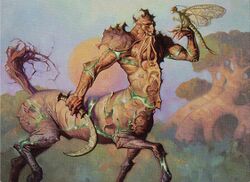Incarnation: Difference between revisions
>Yandere-sliver No edit summary |
>Yandere-sliver No edit summary |
||
| Line 1: | Line 1: | ||
{{Infobox type | |||
|type=creature | |||
|stats={{stats|W=4|U=2|B=2|R=2|G=3}} | |||
}} | |||
'''Incarnation''' literally means embodied in flesh or taking on flesh. It refers to the conception and birth of a sentient creature which is the material manifestation of a [[force]] or concept whose original nature is immaterial. | '''Incarnation''' literally means embodied in flesh or taking on flesh. It refers to the conception and birth of a sentient creature which is the material manifestation of a [[force]] or concept whose original nature is immaterial. | ||
Revision as of 06:30, 13 May 2019
| Incarnation | |
|---|---|
| Creature Type | |
| (Subtype for creature/kindred cards) | |
| Statistics |
13 cards |
| Scryfall Search | |
| type:"Incarnation" | |
Incarnation literally means embodied in flesh or taking on flesh. It refers to the conception and birth of a sentient creature which is the material manifestation of a force or concept whose original nature is immaterial.
As a creature type it first appeared in Judgement. Personal Incarnation from Alpha gained the subtype Incarnation retroactively.
Judgement cycle
Each of these creatures has a static ability that grants all of your creatures an in-color ability as long as it is in your graveyard and you control a land with the associated basic land type.
Genesis and Glory are incarnations with similar abilities in that their abilities only function while they are in the graveyard, but are not part of the cycle.
Lorwyn cycle
Inspired by the original cycle, Lorwyn had a cycle of rare Elemental Incarnations which grant their controllers a powerful effect. In direct contrast to the Judgement cycle, however, the Lorwyn incarnations each have a triggered ability that shuffles them back into their owner's library should they enter the graveyard.
